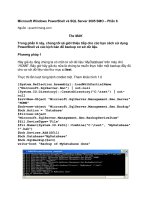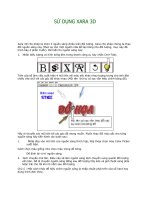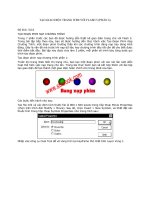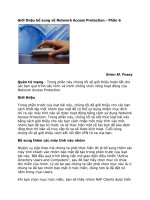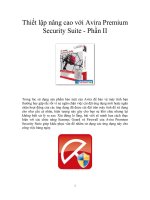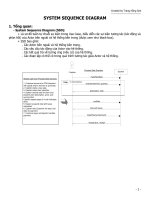Information Security FUNDAMENTALS phần 6 ppt
Bạn đang xem bản rút gọn của tài liệu. Xem và tải ngay bản đầy đủ của tài liệu tại đây (675.25 KB, 26 trang )
5.9.2 Custodian
The next responsibility we must create is that of the information custodian.
This entity is responsible for protecting the information asset based on
the requirements established by the owner. In an organization that has
an information systems organization, the operations group might be con-
sidered the custodian of client data and information. They neither have
the right to permit anyone access to the information asset, nor can they
alter the information in any way without approval from the owner. This
would include any programming or system upgrades that would modify
the information or the output from applications and transactions.
An Information Custodian is the person responsible for over-
seeing and implementing the necessary safeguards to protect
assets, at the level classified by the information owner.
This could be the System Administrator, controlling access to a
computer network; or a specific application program or even
a standard filing cabinet.
This example started out well but finished oddly. Giving examples of
what might be considered a custodian is good. Trying to liken a filing
cabinet to the opening sentence where the policy identifies the custodian
as a “person.” When writing, remember to go back and read what you
just wrote to make sure the concepts match from beginning to end. Do
not try to be cute. Stick to the subject and make sure you say exactly
what needs to be said.
Custodians are authorized system support persons or organiza-
tions (employees, contractors, consultants, vendors, etc.)
responsible for maintaining the safeguards established by own-
ers. The owner designates the custodian. The custodian is the
“steward of the data” for the owner; that is, the Data Center
may be the custodian for business application “owned” by a
business unit.
The use of the term “steward of the data” brings out a point that needs
to be made. Some organizations and cultures prefer other terms than the
ones discussed here. When I was younger, I played Pony League baseball
for a team called the “Custodians.” Our uniforms were the most realistic
because we had the name on the front and numbers on the back. The
other teams had names such as “Tigers” and “Braves” but had some
advertisement about their sponsor on the back. It was not until we played
a few games that the other team started calling us the janitors. Custodian
to some is a noble name; to others, maybe not so noble. So choose your
AU1957_book.fm Page 116 Friday, September 10, 2004 5:46 PM
Copyright 2005 by CRC Press, LLC. All Rights Reserved.
terms wisely. “Curator,” “keeper,” and “guardian” are other terms that
might work.
Recently we were doing work for HIPAA compliance and developing
policies for a hospital. When we discussed the definition for “user,” the
hospital staff started to chuckle and told us that the term “user” had a
totally different meaning there and we needed to find another term.
B. Custodian: Employees designated by the owner to be
responsible for maintaining the safeguards established by the
owner.
It is important to remember that when using the term “employee,” we
are actually discussing the virtual employee. We can only write policy for
employees; for all third parties, a contract must contain compliance
language. Thus, it is perfectly acceptable to identify “employees” even if
we know that someone other than an employee might actually perform the
function. This is true for all employee responsibilities except “owner.” The
owner must be an employee; after all, it is the organization’s information.
5.9.3 User
The final element is the user. This individual is granted permission by the
owner to access the information asset. The user must use the information
in the manner agreed upon with the owner. The user has no other rights.
When granting access, the owner should use the concept of “least privi-
lege.” This means the user is granted only the access he or she specifically
needs to perform a business task, and no more.
An information user is the person responsible for viewing,
amending, or updating the content of the information assets.
This can be any user of the information in the inventory created
by the information owner.
The inventory discussed here is addressed in both the classification
policy and the records management policy, including who has been
assigned access needs to be tracked. The custodian is generally responsible
for providing the tools to monitor the user list.
Users are authorized system users (employees, contractors,
consultants, vendors, etc.) responsible for using and safeguard-
ing information under their control according to the directions
of the owner. Users are authorized access to information by
the owner.
AU1957_book.fm Page 117 Friday, September 10, 2004 5:46 PM
Copyright 2005 by CRC Press, LLC. All Rights Reserved.
The final example is similar to the definition used above:
C. User: Employees authorized by the owner to access infor-
mation and use the safeguards established by the owner.
5.10 Classification Examples
This section examines attributes and examples of different classification
categories, and presents examples of organization information classifica-
tion policies.
5.10.1 Classification: Example 1
Critique of Example 1 (Table 5.6) — This is an actual classification policy
(very high level) for the executive branch of a national government. There
is little here to help the average user. This is an example of a program
or general policy statement; however, a topic-specific policy statement
may have been more beneficial. Perhaps the next two examples will
provide more information.
5.10.2 Classification: Example 2
Critique of Example 2 (Table 5.7) — The policy seems to stress competitive
advantage information in its opening paragraphs. It does not appear to
address personal information about employees or customers. It does pro-
vide for these topics as categories under “Confidential” but it never really
TABLE 5.6 Information Classification Policy: Example 1
Information Classification
Ⅲ Policy: Security classifications should be used to indicate the need and
priorities for security protection.
Objective: To ensure that information assets receive an appropriate level of
protection.
Statement: Information has varying degrees of sensitivity and criticality. Some
items may require an additional level of security protection or special handling.
A security classification system should be used to define an appropriate set of
security protection levels, and to communicate the need for special handling
measures to users.
AU1957_book.fm Page 118 Friday, September 10, 2004 5:46 PM
Copyright 2005 by CRC Press, LLC. All Rights Reserved.
TABLE 5.7 Information Classification Policy: Example 2
Classification Requirements
Classified data is information developed by the organization with some effort
and some expense or investment that provides the organization with a com-
petitive advantage in its relevant industry and that the organization wishes to
protect from disclosure.
While defining information protection is a difficult task, four elements serve
as the basis for a classification scheme:
1. The information must be of some value to the organization and its com-
petitors so that it provides some demonstrable competitive advantage.
2. The information must be the result of some minimal expense or invest-
ment by the organization.
3. The information is somewhat unique in that it is not generally known in
the industry or to the public or may not be readily ascertained.
4. The information must be maintained as a relative secret, both within and
outside the organization, with reasonable precautions against disclosure
of the information. Access to such information could only result from
disregarding established standards or from using illegal means.
Top Secret (Secret, Highly Confidential)
Attributes:
Ⅲ Provides the organization with a very significant competitive edge
Ⅲ Is of such a nature that unauthorized disclosure would cause severe
damage to the organization
Ⅲ It shows specific business strategies and major directions
Ⅲ Is essential to the technical or financial success of a product
Examples:
Ⅲ Specific operating plans, marketing strategies
Ⅲ Specific descriptions of unique parts or materials, technology intent
statements, new technologies and research
Ⅲ Specific business strategies and major directions
Confidential (Sensitive, Personal, Privileged)
Attributes:
Ⅲ Provides the organization with a significant competitive edge
Ⅲ Is of such a nature that unauthorized disclosure would cause damage
to the organization
Ⅲ Shows operational direction over an extended period of time
Ⅲ Is extremely important to the technical or financial success of a product
AU1957_book.fm Page 119 Friday, September 10, 2004 5:46 PM
Copyright 2005 by CRC Press, LLC. All Rights Reserved.
mentions them by name. This appears to be a policy that is somewhat
limited in scope. Additionally, it does not establish the scope of the
information (is it computer generated only or exactly what information is
being addressed?). The employee responsibilities are missing. What is
management’s responsibility with respect to information classification, and
what is expected of the employees? Finally, what are the consequences
of noncompliance?
Examples:
Ⅲ Consolidated revenue, cost, profit, or other financial results
Ⅲ Operating plans, marketing strategies
Ⅲ Descriptions of unique parts or materials, technology intent statements,
new technological studies and research
Ⅲ Market requirements, technologies, product plans, and revenues
Restricted (Internal Use)
Attributes:
Ⅲ All business-related information requiring baseline security protection,
but failing to meet the specified criteria for higher classification
Ⅲ Information that is intended for use by employees when conducting
company business
Examples:
Ⅲ Business information
Ⅲ Organization policies, standards, procedures
Ⅲ Internal organization announcements
Public (Unclassified)
Attributes:
Ⅲ Information that, due to its content and context, requires no special
protection, or
Ⅲ Information that has been made available to the public distribution
through authorized company channels
Examples:
Ⅲ Online public information, Web site information
Ⅲ Internal correspondence, memoranda, and documentation that do not
merit special controls
Ⅲ Public corporate announcements
TABLE 5.7 (continued) Information Classification Policy: Example 2
AU1957_book.fm Page 120 Friday, September 10, 2004 5:46 PM
Copyright 2005 by CRC Press, LLC. All Rights Reserved.
5.10.3 Classification: Example 3
Critique of Example 3 (Table 5.8) — Examples 2 and 3 are very similar.
Example 3 does address the role of the owner but fails to define what
an owner is. It does not address the issue of noncompliance, and the
scope of the policy is vague.
5.10.4 Classification: Example 4
Critique of Example 4 (Table 5.9) — The intent of the policy states that
“Information is a corporate asset and is the property of Corporation.” The
scope of the policy states that “Corporate information includes electroni-
cally generated, printed, filmed, typed, or stored.” The responsibilities are
well-established. The issue of compliance is the only policy element that
appears lacking.
5.11 Declassification or Reclassification
of Information
Part of an effective information classification program is the ability to
combine the requirements with a Records Management Policy. Information
assets must be protected, stored, and then destroyed, based on a policy
and a set of standards. The Information Classification Policy will ensure
that an owner is assigned to each asset, that a proper classification is
assigned, and that an information handling set of standards will help
maintain control of information copies.
The Records Management Policy requires the owner to provide a brief
description of the information record and the record retention require-
ments. These requirements will be a set of standards that support the
Records Management Policy. We briefly examine what typically is part of
the Records Management Policy.
5.12 Records Management Policy
An organization’s records are one of its most important and valuable
assets. Almost every employee is responsible for creating or maintaining
organization records of some kind, whether in the form of paper, computer
data, optical disk, electronic mail, or voice-mail. Letters, memoranda, and
contracts are obviously information records, as are things such as a desk
calendar, an appointment book, or an expense record.
AU1957_book.fm Page 121 Friday, September 10, 2004 5:46 PM
Copyright 2005 by CRC Press, LLC. All Rights Reserved.
TABLE 5.8 Information Classification Policy: Example 3
INFORMATION CLASSIFICATION
Introduction
Information, wherever it is handled or stored (for example, in computers, file
cabinets, desktops, fax machines, voice-mail), needs to be protected from
unauthorized access, modification, disclosure, and destruction. All informa-
tion is not
created equal. Consequently, segmentation or classification of
information into categories is necessary to help identify a framework for
evaluating the information’s relative value and the appropriate controls re-
quired to preserve its value to the company.
Three basic classifications of information have been established. Organiza-
tions may define additional subclassifications as necessary to complete their
framework for evaluating and preserving information under their control.
When information does require protection, the protection must be consis-
tent. Often, strict access controls are applied to data stored in the mainframe
computers but not applied to office workstations. Whether in a mainframe,
client/server, workstation, file cabinet, desk drawer, waste basket, or in the
mail, information should be subject to appropriate and consistent protection.
The definitions and responsibilities described below represent the mini-
mum level of detail necessary for all organizations across the company. Each
organization may decide that additional detail is necessary to adequately
implement information classification within their organization.
Corporate Policy: All information must be classified by the owner
into one of three classifications: Confidential, Internal Use or Public.
(From Company Policy on Information Management)
Confidential
Definition: Information that, if disclosed, could:
Ⅲ Violate the privacy of individuals,
Ⅲ Reduce the company’s competitive advantage, or
Ⅲ Cause damage to the company.
Examples: Some examples of Confidential information are:
Ⅲ Personnel records (including name, address, phone, salary, performance
rating, social security number, date of birth, marital status, career path,
number of dependents, etc.),
Ⅲ Customer information (including name, address, phone number, energy
consumption, credit history, social security number, etc.),
Ⅲ Shareholder information (including name, address, phone number,
number of shares held, social security number, etc.),
Ⅲ Vendor information (name, address, product pricing specific to the com-
pany, etc.),
AU1957_book.fm Page 122 Friday, September 10, 2004 5:46 PM
Copyright 2005 by CRC Press, LLC. All Rights Reserved.
Organizations are required by law to maintain certain types of records,
usually for a specified period of time. The failure to retain such documents
for these minimum time periods can subject an organization to penalties,
fines, or other sanctions, or could put it at a serious disadvantage in
Ⅲ Health insurance records (including medical, prescription, and psycho-
logical records),
Ⅲ Specific operating plans, marketing plans, or strategies,
Ⅲ Consolidated revenue, cost, profit, or other financial results that are not
public record,
Ⅲ Descriptions of unique parts or materials, technology intent statements,
or new technologies and research that are not public record,
Ⅲ Specific business strategies and directions,
Ⅲ Major changes in the company’s management structure, and
Ⅲ Information that requires special skill or training to interpret and employ
correctly, such as design or specification files.
If any of these items can be found freely and openly in public records, the
company’s obligation to protect from disclosure is waived.
Internal Use
Definition: Classify information as Internal Use when the information is in-
tended for use by employees when conducting company business.
Examples: Some examples of Internal Use information are:
Ⅲ Operational business information/reports,
Ⅲ Noncompany information that is subject to a nondisclosure agreement
with another company,
Ⅲ Company phone book,
Ⅲ Corporate policies, standards, and procedures, and
Ⅲ Internal company announcements.
Public
Definition: Classify information as Public if the information has been made
available for public distribution through authorized company channels. Public
information is not sensitive in context or content, and requires no special
protection.
Examples: The following are examples of Public information:
Ⅲ Corporate Annual Report
Ⅲ Information specifically generated for public consumption, such as pub-
lic service bulletins, marketing brochures, and advertisements)
TABLE 5.8 (continued) Information Classification Policy: Example 3
AU1957_book.fm Page 123 Friday, September 10, 2004 5:46 PM
Copyright 2005 by CRC Press, LLC. All Rights Reserved.
TABLE 5.9 Information Classification Policy: Example 4
Information Management
1. General
A. Corporate information includes electronically generated, printed,
filmed, typed, or stored.
B. Information is a corporate asset and is the property of Corporation.
2. Information Retention
A. Each organization shall retain information necessary to the conduct
of business.
B. Each organizational unit shall establish and administer a records
management schedule in compliance with applicable laws and reg-
ulations, and professional standards and practices, and be compat-
ible with Corporate goals and expectations.
3. Information Protection
A. Information must be protected according to its sensitivity, criticality,
and value, regardless of the media on which it is stored, the manual
or automated systems that process it, or the methods by which it
is distributed.
B. Employees are responsible for protecting corporate information
from unauthorized access, modification, destruction, or disclosure,
whether accidental or intentional. To facilitate the protection of
corporate information, employee responsibilities have been estab-
lished at three levels: Owner, Custodian, and User.
1) Owner: Company management of the organizational unit where
the information is created, or management of the organizational
unit that is the primary user of the information. Owners are
responsible to:
a) Identify the classification level of all corporate information
within their organizational unit,
b) Define appropriate safeguards to ensure the confidentiality,
integrity, and availability of the information resource,
c) Monitor safeguards to ensure they are properly imple-
mented,
d) Authorize access to those who have a business need for the
information, and
e) Remove access from those who no longer have a business
need for the information.
2) Custodian: Employees designated by the owner to be responsi-
ble for maintaining the safeguards established by the owner.
3) User: Employees authorized by the owner to access information
and use the safeguards established by the owner.
AU1957_book.fm Page 124 Friday, September 10, 2004 5:46 PM
Copyright 2005 by CRC Press, LLC. All Rights Reserved.
litigation. Therefore, every organization should implement a Record Man-
agement Policy to provide standards for maintaining complete and accurate
records to ensure that employees are aware of what records to keep and
for how long, what records to dispose of, and how to dispose of them.
The cost of storage and administration problems involved in retaining
material beyond its useful life are a few important reasons to establish a
Records Management Policy. Consideration should also be given to the
impact that a failure to produce subpoenaed records might have on the
organization when defending itself against a lawsuit. Determining the
proper retention periods for information records is a requirement in today’s
operating environment. Information records should be kept only as long
as they serve a useful purpose or until legal requirements are met. At the
end of the retention period, records should be destroyed in a verifiable
manner. Implementing effective information classification and records
management policies makes sound business sense and shows that man-
agement is practicing due diligence.
Before drafting a Records Management Policy, consult with your legal
staff to ensure that the policy reflects any relevant statutes. The retention
standards that support the policy should be reviewed annually when
conducting an organizationwide information asset inventory.
C. Each Vice President shall appoint an Organization Information
Protection Coordinator who will administer an information protec-
tion program that appropriately classifies and protects corporate
information under the Vice President’s control and makes employ-
ees aware of the importance of information and methods for its
protection.
4. Information Classification: To ensure the proper protection of corpo-
rate information, the owner shall use a formal review process to classify
information into one of the following classifications:
A. Public: Information that has been made available for public distri-
bution through authorized company channels. (Refer to Commu-
nication Policy for more information.)
B. Confidential: Information that, if disclosed, could violate the privacy
of individuals, reduce the company’s competitive advantage, or
could cause significant damage to the company.
C. Internal Use: Information that is intended for use by all employees
when conducting company business. Most information used in the
company would be classified Internal Use.
TABLE 5.9 (continued) Information Classification Policy: Example 4
AU1957_book.fm Page 125 Friday, September 10, 2004 5:46 PM
Copyright 2005 by CRC Press, LLC. All Rights Reserved.
5.12.1 Sample Records Management Policy
See Table 5.10 for a sample Records Management Policy.
5.13 Information Handling Standards Matrix
Later in the book we discuss standards and how they support the imple-
mentation of the policy. Because information classification and records
management are unique in their standards requirements, it is appropriate
to give examples now of what these standards might look like. When
developing your standards, use these as a guideline — not a standard.
5.13.1 Printed Material
See Table 5.11 for an information handling matrix for printed material.
5.13.2 Electronically Stored Information
See Table 5.12 for an information handling matrix for electronically stored
information.
5.13.3 Electronically Transmitted Information
See Table 5.13 for an information handling matrix for electronically trans-
mitted information.
5.13.4 Record Management Retention Schedule
See Table 5.14 for a sample record retention schedule.
5.14 Information Classification Methodology
The final element in an effective information classification process is to
provide management and employees with a method to evaluate informa-
tion and provide them with an indication of where the information should
be classified (see Table 5.15). To accomplish this, it may be necessary to
create information classification worksheets. These worksheets can be
used by the business units to determine what classifications of information
they have within their organization.
AU1957_book.fm Page 126 Friday, September 10, 2004 5:46 PM
Copyright 2005 by CRC Press, LLC. All Rights Reserved.
TABLE 5.10 Sample Records Management Policy
Records Management Policy
Introduction
It is the policy of the Company to accommodate the timely storage, retrieval,
and disposition of records created, utilized, and maintained by the various
departments. The period of time that records are maintained is based on the
minimum requirements set forth in State and Federal retention schedules.
1. Role of Retention Center
The role of the Retention Center is to receive, maintain, destroy, and service
inactive records that have not met their disposition date. Each business unit
is to establish schedules to comply with the minimum amount of time records
should be maintained in compliance with State and Federal guidelines. Re-
tention requirements apply whether or not the records are transferred to the
Retention Center. Copies of the schedules must be maintained by the busi-
ness unit and available for inspection.
2. Role of the Records Manager
The role of the Records Manager is to administer the Records Management
program. The Records Manager is well acquainted with all records and record
groups within an agency and has expertise in all aspects of records manage-
ment. The duties of the Records Manager include planning, development,
and administration of records management policies. These duties also in-
clude the annual organizationwide inventory of all information assets to be
conducted by the business unit manager with reports sent to the Records
Manager.
3. Role of Management Personnel
Management Personnel are responsible for records under their control.
4. Role of Departmental Records Coordinator
The Departmental Records Coordinator is to be a liaison between the de-
partment and the Retention Center. It is recommended that each department
appoint a Records Coordinator in writing. The letter of appointment should
include the Records Coordinator’s full name, department, and telephone
extension. The letter should be forwarded to the Retention Center and main-
tained on file.
5. Type of Documents Maintained in Retention Center
5.1 Record Retention accepts only public records that are referenced
in the State Retention Schedule, except student transcripts. Copies
of student transcripts may be obtained from Records and Admis-
sions located at the Student Service Center.
5.2 Record Retention does not accept personal, active, or nonrecords.
AU1957_book.fm Page 127 Friday, September 10, 2004 5:46 PM
Copyright 2005 by CRC Press, LLC. All Rights Reserved.
5.3 Record Retention stores only inactive and permanent records until
final disposition according to State and Federal retention schedules.
Examples include personnel files, purchase orders, grade books, or
surveys.
5.4 Record Retention receives and stores inactive permanent records
from TVI departments until final disposition according to State and
Federal retention guidelines.
5.5 Record Retention ensures records are classified according to State
and Retention guidelines.
5.6 Record Retention ensures records are tracked and entered into an
electronic records management software system that tracks record
boxes, assigns retention schedules, and records permanent box
numbers, destruction dates, and shelf locations.
6. Services
6.1 If a department has obsolete records that are deemed confidential
or sensitive, or copies of nonrecords, a special request for shredding
may be sent to the Record Retention Center. The records can be
shredded by the Record Retention Center staff or transferred to the
State Record Center for destruction.
6.2 Departments must complete a Request for Destruction form for
confidential or nonrecords to be shredded. Departments are re-
quired to purchase forms from Central Stores at Shipping & Receiv-
ing.
6.3 The Record Retention Center provides consulting services to de-
partments on filing systems and maintenance of records.
7. Transferring Records
7.1 Departments should transfer records to Record Retention for stor-
age in January, July, and October.
7.2 Records with a retention period of two years or more should be
transferred to Record Retention.
8. Record Retrieval
8.1 Records are retrieved and delivered to customers by request, given
a 24-hour notice.
8.2 Records can be retrieved for customers on an emergency basis as
requested.
8.3 Management personnel, the records coordinator, or the requester
will sign for receipt of records. Records are to be checked out for
no longer than 30 days. If a longer period is required, a written
request should be sent to the Retention Center. If records are
checked out for more than a year, the records will be permanently
withdrawn from inventory.
TABLE 5.10 (continued) Sample Records Management Policy
AU1957_book.fm Page 128 Friday, September 10, 2004 5:46 PM
Copyright 2005 by CRC Press, LLC. All Rights Reserved.
To complete this worksheet, the employee would fill in the information
requested at the top of the worksheet:
Ⅲ Organization: the department designated as the information owner
Ⅲ Group: the reporting group of the individual performing the infor-
mation classification process
8.4 Permanent Withdrawal: If a department wishes to withdraw a record
permanently from storage, forward a request to Record Retention by
phone, fax, or inter-office mail. The department will complete a With-
drawal Request form and the records will be deleted from inventory.
8.5 Second-Party Withdrawal: If a department requests a record origi-
nating from another department, then the requesting department
must contact the department of origin to obtain authorization. The
department of origin will contact Record Retention for records with-
drawal. The department requester must view the requested records
at the Record Retention Center.
8.6 Records should not be returned via inter-office mail due to the
confidential nature of the documents.
9. Record Destruction
9.1 Record Retention destroys records according to State guidelines in
January, July, and October.
9.2 Records are destroyed by Record Retention according to State and
Federal guidelines when legal requirements are met. A Destruction
Request form will be sent to the originating department for review
and signature by the Departmental Records Coordinator and by
management personnel. Only when the Destruction Request has
been reviewed, signed, and returned to Record Retention will the
expired records be destroyed. Authorized personnel will shred con-
fidential records. If departments wish to keep the records past their
assigned destruction date, management personnel can extend the
date no longer than one year unless a litigation, audit, or investiga-
tion is pending. Records kept by the department past the retention
date of destruction will be permanently withdrawn from inventory.
9.3 All records scheduled for destruction are reviewed by the Institute’s
Records Manager and by State Records Analysts for approval.
10. Supplies
10.1 Records must be stored in the appropriate record retention boxes,
which are obtained from Central Stores at Shipping & Receiving.
10.2 Storage Ticket forms and Request for Destruction forms are ob-
tained from Central Stores at Shipping & Receiving.
TABLE 5.10 (continued) Sample Records Management Policy
AU1957_book.fm Page 129 Friday, September 10, 2004 5:46 PM
Copyright 2005 by CRC Press, LLC. All Rights Reserved.
Ⅲ Review Performed by/Phone: the name and phone number of the
individual performing the review
Ⅲ Date: the date of the review
Ⅲ Information Name/Description: an identifier or description of the
information being reviewed
TABLE 5.11 Information Handling Matrix for Printed Material
Printed Material Handling Standards
Confidential Internal Use Public
Labeling of
documents
Document should
identify owner and be
marked “CONFIDEN-
TIAL” on cover or title
page
No special
requirements
Document may
be marked
“PUBLIC” on
cover or title
page
Duplication
of
documents
Information owner to
determine permissions
Duplication
for business
purposes
only
No special
requirements
Mailing
of
documents
No classification mark-
ing on external enve-
lope; “CONFIDENTIAL”
marking on cover
sheet; confirmation of
receipt at discretion of
information owner
Mailing re-
quirements
determined
by informa-
tion owner
No special
requirements
Disposal
of
documents
Owner observed physi-
cal destruction beyond
ability to recover
Controlled
physical
destruction
No special
requirements
Storag
e of
documents
Locked up when not in
use
Master copy
secured
against
destruction
Master copy
secured
against
destruction
Read
access to
documents
Owner establishes user
access rules; generally
highly restricted
Owner estab-
lishes user
access rules,
generally
widely
available
No special
requirements;
generally avail-
able within
and outside
company
Review
of
document
classification
level
Information owner to
establish specific
review date (not to
exceed one year)
Information
owner to
review at
least annually
No special
requirements
AU1957_book.fm Page 130 Friday, September 10, 2004 5:46 PM
Copyright 2005 by CRC Press, LLC. All Rights Reserved.
TABLE 5.12 Information Handling Matrix for Electronically
Stored Information
Electronically Stored Information Handling Matrix
Confidential Internal Use Public
Storage on fixed
media (access
controlled)
Unencrypted Unencrypted Unencrypted
Storag
e on fixed
media (not ac-
cess controlled)
Encrypted Unencrypted Unencrypted
Storag
e on re-
movable media
Encrypted Unencrypted Unencrypted
Read
access to in-
formation (in-
cludes
duplication)
Information owner
to authorize indi-
vidual users
Information
owner to define
permissions on
user, group, or
function basis
No special
requirements
Update
access to
information
Information owner
to authorize indi-
vidual users
Information
owner to define
permissions on
user, group, or
function basis
Information
owners to
define
permissions
Delete
access to
information
Information owner
to authorize indi-
vidual users; user
confirmation
required
Information
owner to define
permissions on
user, group, or
function basis;
user confirma-
tion required
Information
owner to
define
permissions
hard copy
report of infor-
mation
Output to be
routed to a
predefined,
monitored printer
Information
owner to define
permissions
No special
requirements
Internal labeling
of information at
the application
or screen/display
level
Notification of
“CONFIDENTIAL”
to appear at top
of display
No special re-
quirements
Notification of
“PUBLIC”
may optional-
ly appear at
top of display
External labeling
of exchangeable
media
Media must identi-
fy owner and be
marked CONFI-
DENTIAL
Marking at
discretion of
owner
No special
requirements
AU1957_book.fm Page 131 Friday, September 10, 2004 5:46 PM
Copyright 2005 by CRC Press, LLC. All Rights Reserved.
In the section for Information Name/Description, it is necessary to enter
the information type. For example:
Ⅲ Employee Records:
Ⅲ Employee performance review records
Ⅲ Timecards
Ⅲ Employee discipline documents
Ⅲ Pay records
Ⅲ Medical records
TABLE 5.12 (continued) Information Handling Matrix for Electronically
Stored Information
Electronically Stored Information Handling Matrix
Confidential Internal Use Public
Disposal of
electronic media
(diskettes, tapes,
hard disks, etc.)
Owner observed
physical
destruction
beyond ability to
recover
Physical
destruction
No special
requirements
Disposal
of
information
Delete by fully
writing over
information
Delete files
through normal
platform delete
command,
option, or
facility
No special
requirements
Review
of
classified
information for
reclassification
Information owner
to establish
specific review
date (not to
exceed one year)
Information
owner to
review annually
Information
owner to
review
annually
L
ogging access
activity
Log all access
attempts;
information
owner to review
all access and
violation attempts
Log all violation
attempts;
information
owner reviews
as
appropriate
No special
requirements
Access
report
retention
requirements
Information owner
to determine
retention of
access logs (not to
exceed one year)
Information
owner to
determine
retention of
violation logs
(not to exceed
six months)
No special
requirements
AU1957_book.fm Page 132 Friday, September 10, 2004 5:46 PM
Copyright 2005 by CRC Press, LLC. All Rights Reserved.
Ⅲ Group Administrative Records:
Ⅲ Monthly status reports
Ⅲ Yearly status reports
Ⅲ Yearly business objectives
Ⅲ Business Process Records
Ⅲ Purchasing contracts
Ⅲ Quarterly financial reports
Ⅲ Project management tasks, schedules
Ⅲ Reference manuals
Ⅲ Contract negotiations
TABLE 5.13 Information Handling Matrix for Electronically
Transmitted Information
Electronically Transmitted Information Handling Standards
Confidential Internal Use Public
By FAX Attended at receiving
FAX
Information
owner to define
requirements
No special
requirements
By WAN Confirmation of
receipt required;
encryption optional
No special
requirements;
encryption
optional
No special
requirements
By LAN Confirmation of
receipt required;
encryption optional
No special
requirements;
encryption
optional
No special
requirements
By inter-
office mail
No external labeling
on envelope; normal
labeling on
document
No special
requirements
No special
requirements
By voice-mail Confirmation of
receipt required
(sender); remove
message after receipt
(recipient)
No special
requirements
No special
requirements
By electronic
messaging
(e-mail)
Confirmation of
receipt required;
encryption optional
No special
requirements
No special
requirements
By wireless or
cellular
phone
Do not transmit No special
requirements
No special
requirements
AU1957_book.fm Page 133 Friday, September 10, 2004 5:46 PM
Copyright 2005 by CRC Press, LLC. All Rights Reserved.
TABLE 5.14 Sample Record Retention Schedule
Records Management (Retention) Schedule
Record Retain Record Retain
Accounts payable
schedules
Permanent General ledgers Permanent
Accounts receivables
schedules
Permanent Insurance policies Until
expiration
Bank drafts and paid
notices
10 Years Internal repair orders
(hardcopy only)
7 Years
Bank statements and
reconciliations
10 Years Internal sales journals Permanent
Bills of lading 7 Years Journal vouchers Permanent
Cancelled checks 10 Years Miscellaneous schedules Permanent
Cash disbursements
journals
Permanent New and used vehicle
records
7 Years
Cash receipts journals Permanent New vehicle sales journals Permanent
Claims register 7 Years Office receipts 7 Years
Corporate minutes
book
Permanent Parts, accessories, and
service sales journals
Permanent
Correspondence 10 Years Payroll journals Permanent
Counter tickets 7 Years Prepaid and accrued
expense schedule
2 Years
CPA audit reports Permanent Property tax returns Permanent
Credit memos 7 Years Purchase journals Permanent
Customer files 7 Years Purchase orders 7 Years
Customer repair orders
(both office and hard
copy)
7 Years Receiving reports 7 Years
Documents pertaining
to litigation
Permanent Repair order check sheet 2 Years
Duplicate deposit slips 10 Years Repair orders — internal
(office copy only)
2 Years
Employee earning and
history record
Permanent Sales invoices 7 Years
Employment contracts Permanent Salesperson’s commission
reports
Permanent
Federal revenue agents’
reports and related
papers
Permanent Social security tax returns Permanent
Federal tax returns Permanent State and local sales tax
returns
Permanent
Financial statements Permanent State annual reports Permanent
AU1957_book.fm Page 134 Friday, September 10, 2004 5:46 PM
Copyright 2005 by CRC Press, LLC. All Rights Reserved.
Ⅲ Operations Information:
Ⅲ Business partner information
Ⅲ Asset allocation
Ⅲ Trading activities
Ⅲ Production formulas
Ⅲ Production cost information
Ⅲ Customer lists
Ⅲ Distribution Records:
Ⅲ Distribution models
Ⅲ Inventory records
Ⅲ Parts supplies
Using the definitions, the person(s) performing the review would place
a checkmark in the appropriate column; only one checkmark for each
item being reviewed. This process would allow the user department to
identify all the various types of information found in the department and
then be able to determine under which classification they probably fall.
5.15 Authorization for Access
To establish a clear line of authority, some key concepts must be estab-
lished. As discussed above, there are typically three categories of employee
responsibilities. Depending on the specific information being accessed,
an individual may fall into more than one category. For example, an
employee with a desktop workstation becomes the owner, custodian, and
user. To better help understand the concepts, the responsibilities of each
category are listed below.
TABLE 5.14 (continued) Sample Record Retention Schedule
Records Management (Retention) Schedule
Record Retain Record Retain
General journals Permanent State franchise tax returns Permanent
Sundry invoices 7 Years
Timecards 2 Years
Federal and state
unemployment tax
returns
Permanent
Used and repossessed
vehicles journals
Permanent
Vehicle invoices 7 Years
AU1957_book.fm Page 135 Friday, September 10, 2004 5:46 PM
Copyright 2005 by CRC Press, LLC. All Rights Reserved.
TABLE 5.15
Information Classification Worksheet
Information Classification Review Worksheet
Organization: ________________________________________________________
Group: __________________________________
Review Performed by/Phone: __________________________________________
Date: ____________________________________
Information
Name/Description
Storage
Medium
Classifications (Select One)
CONFIDENTIAL
RESTRICTED
INTERNAL USE
PUBLIC
If disclosed, could violate the
privacy of individuals, reduce
the company’s competitive
advantage, or cause damage
to the company.
Intended for use by a
subset of employees when
conducting company
business (usually
regulatory requirement)
Intended for use
by all employees
when conducting
company
business.
Made available for
public distribution
through authorized
company channels.
Employee Records
1
2
3
4
5
6
Group Administrative
Records
1
2
AU1957_book.fm Page 136 Friday, September 10, 2004 5:46 PM
Copyright 2005 by CRC Press, LLC. All Rights Reserved.
3
4
5
6
7
Business Process Records
1
2
3
4
5
6
7
8
9
10
AU1957_book.fm Page 137 Friday, September 10, 2004 5:46 PM
Copyright 2005 by CRC Press, LLC. All Rights Reserved.
5.15.1 Owner
Minimally, the information owner is responsible for:
Ⅲ Judging the value of the information resource and assigning the
proper classification level
Ⅲ Periodically reviewing the classification level to determine if the
status should be changed
Ⅲ Assessing and defining appropriate controls to ensure that infor-
mation created is properly safeguarded from unauthorized access,
modification, disclosure, or destruction
Ⅲ Communicating access and safeguard requirements to the informa-
tion custodian and users
Ⅲ Providing access to those individuals with a demonstrated business
need for access
Ⅲ Assessing the risk of loss of the information and ensuring that
adequate safeguards are in place to mitigate the risk to information
integrity, confidentiality, and availability
Ⅲ Monitoring safeguard requirements to ensure that information is
being adequately protected
Ⅲ Ensuring that a business continuity plan has been implemented
and tested to protect information availability
5.15.2 Custodian
At a minimum, the custodian is responsible for:
Ⅲ Providing proper safeguards for processing equipment, information
storage, backup, and recovery
Ⅲ Providing a secure processing environment that can adequately
protect the integrity, confidentiality, and availability of information
Ⅲ Administering access requests to information properly authorized
by the owner
5.15.3 User
The user is responsible for:
Ⅲ Using the information only for the purpose intended
Ⅲ Maintaining the integrity, confidentiality, and availability of infor-
mation accessed
AU1957_book.fm Page 138 Friday, September 10, 2004 5:46 PM
Copyright 2005 by CRC Press, LLC. All Rights Reserved.
Being granted access to information does not imply or confer authority
to grant other users access to that information. This is true whether the
information is electronically held, printed, hardcopy, manually prepared,
copied, or transmitted.
5.16 Summary
Information classification drives the protection control requirements and
this allows information to be protected to a level commensurate to its
value to the organization. The cost of over-protection is eliminated and
exceptions are minimized. With a policy and methodology, specifications
are clear and accountability is established.
There are costs associated with implementing a classification system.
The most identifiable costs include labeling classified information, imple-
menting and monitoring controls and safeguards, and proper handling of
confidential information.
Information, wherever it is handled or stored, needs to be protected
from unauthorized access, modification, disclosure, and destruction. All
information is not created equal. Consequently, segmentation or classifi-
cation of information into categories is necessary to help identify a
framework for evaluating the information’s relative value. By establishing
this relative value, it will be possible to establish cost effective controls
that will preserve the information asset for the organization.
The information classification program will require the identification
of the record type, the owner, and the classification level. Two thirds of
this information may already be gathered by the records management
program. Link these two vital processes together to ensure that employee
time is not wasted on redundant activities. By combining the effort, the
organization will have a better overall information security program.
AU1957_book.fm Page 139 Friday, September 10, 2004 5:46 PM
Copyright 2005 by CRC Press, LLC. All Rights Reserved.
Chapter 6
Access Control
What is access control? Access control is the technical mechanism that
restricts unauthorized users from the system, grants access to authorized
users, and limits what authorized users can do on the system. As such,
access controls in addition to security policy are the key components of
information security. There are several ways in which an organization can
implement access control. There are two popular models to follow when
it comes to access control: mandatory and discretionary.
6.1 Business Requirements for Access Control
6.1.1 Access Control Policy
In mandatory access control, the permission granted on the system is
defined by policy. This is often used in highly secure and government
installations. This policy requires a process known as labeling, where each
user, file, and system is grouped in security categories. Most private-sector
businesses stay away from mandatory access control because of the
increased overhead in labeling all users and systems. With mandatory
access control, each user is given a label or security clearance, which
then governs the amount of access the person will have on the system.
Another popular access control system is discretionary access control.
With discretionary access, permissions are not granted by policy but rather
granted by the data or system owner. The reduced overhead of discre-
tionary access control makes it more applicable to most private-sector
companies. With discretionary access control there is also the possibility
AU1957_C006.fm Page 141 Monday, September 20, 2004 3:23 PM
Copyright 2005 by CRC Press, LLC. All Rights Reserved.
